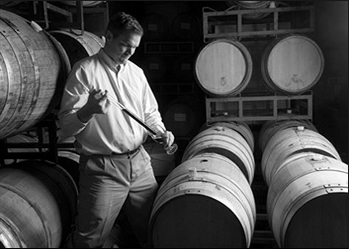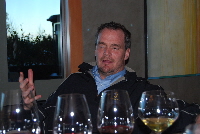A couple of years ago some Napa winemaker friends suggested we visit Alpha Omega Winery on Hwy 29 near St. Helena in Napa Valley. The tasting room is sleek and modern but more importantly the wines were phenomenal. On that trip we had the pleasure of meeting their winemaker Jean Hoefliger and were captivated by his passion and energy. Since then we have visited A/O and Jean many times.
Jean is a big broad-shouldered guy who wears his zeal on his sleeve. He speaks of wine as emotion and art intended to create a “deeply moving reaction, good or bad”. As you will see, Jean’s winemaking style and philosophy is unique and is considered “high risk.” Long natural barrel fermentation, often leaving his red wines on skins for up to 90 days, is his trademark technique which creates wines that are delicious, intriguing and complex.
Pull up a chair and a glass of wine. Join Jean and myself as we explore his fascinating and passionate approach to his “art.”
B&B Wine Blog:You were raised in Switzerland and planned to join the international finance world after law school. What called you from finance to winemaking?
JH: The love of wine and the fact that my dad is a wine lover and opened great wines at the table all my life.
B&B Wine Blog:During your career you have made wine in South Africa, France and California. You could have ended up making wine anywhere. Why did you choose Napa Valley?
JH:You can add Switzerland and Italy to that list as well. I decided to go to Napa Valley because Napa gives all the possibility and freedom to a winemaker to express himself, you are not limited by laws, tradition or climate.
B&B Wine Blog: You served four years as the winemaker for Newton, a very established winery before joining A/O as it started. What were some of your biggest challenges moving to a new winery?
JH: Well, find the right vineyard and brand identity. You really design the DNA of a wine when you start a winery and part of the challenge is to be able to understand the connection between a brand and the style of wine that would make the brand consistent.
B&B Wine Blog: You speak passionately about wine as art. What does that mean to you?
JH: That all the decisions you have to make need to come from the heart in order to create an emotion in the people drinking it. My definition of art is creating an emotion, good or bad, that is the taste. The emotion is art.
B&B Wine Blog: What is your take on wine critics in general?
JH: They represent a way for wine drinkers to gain confidence in their tasting ability and create their own opinion on wine. However, the critic is just one palate. Consumers should compare their palate to the critic’s and follow the critic whose palate serves them best.
B&B Wine Blog: You have been called by some, including your partners, as a “high risk winemaker.” Please explain.
JH: Because I make wine in a very different way. I naturally ferment wine which takes an average of 10 months (with industrial yeast about 3 weeks). In addition to that, I macerate the wine for an average of 70-90 days when most do it for 21 to 30 days. If you add to that that I am not fining or filtering, it is a true risk.
B&B Wine Blog:70-90 days of skin contact (maceration) as you said, is an unusually long time. Many would assume this technique would produce highly tannic wines but in fact they are very well integrated and smooth. Why are your wines free of mouth biting tannins?
JH: First, the grapes are picked ripe. Also, during barrel fermentation and long skin contact the tannins that are unstable fall out when in contact with skins and air for so long.
B&B Wine Blog: The winery also uses steel fermentation tanks. What wines are fermented there?
JH: Outside of Era which is usually 100% Barrel fermented all the others are 50% barrel and 50% tank fermented to bring more complexity to the wine.
B&B Wine Blog:Your Chardonnays are very well balanced and not overly oaked. Are they also fermented in oak? If yes, how do you achieve such a gentle balance?
JH: The Chardonnay is 100% barrel fermented but one must adapt to the vintage. The grapes come from cold sites that have a very high acidity. If the grapes have high acidity you can stir the lees to balance it out. This will limit the effect of the oak on the wine because the lees absorb the wood notes.
B&B Wine Blog: Most, if not all, of your wines are unfiltered. What does that add to the wine?
JH:It does not add anything to the wine. It just doesn’t change it. If I throw you against a wall you will end up alive on the other side but you will never be the same person 😉 same with filtration and wine.
 B&B Wine Blog: You are well known for spending up to three hours barrel tasting your wines almost daily. What does this intimate knowledge of the wines add to the greatness of the final product?
B&B Wine Blog: You are well known for spending up to three hours barrel tasting your wines almost daily. What does this intimate knowledge of the wines add to the greatness of the final product?
JH: Adapting to the needs of the wine and never applying recipes to your wines. This helps to really maximize the potential of the wine.
B&B Wine Blog: You could work with any consulting winemaker. Since 2006 you have worked with famed Bordeaux based consultant Michel Rolland. What does Mr. Rolland add to your experience as a winemaker and to Alpha Omega wines?
JH: He doubts me. We get along really well and I know that he will tell me the truth, point out where we can improve and not tell me that the wines are great. I call him the doubter.
B&B Wine Blog: Alpha Omega red wines often receive scores in the mid to high 90’s. That is quite an achievement. What one thing do you think makes you such a successful winemaker?
JH: Thank you, but yet again it is just the perception of the writer and all I can say is a lot of heart and passion go into that. I just let my heart and instinct talk.
Brought to you by Bacchus and Beery Wine Blog
